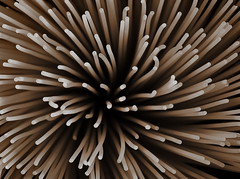Pasta
has become synonymous with Italian cuisine the world over. Eaten on all five continents, it has become Italy's culinary flag embraced globally. "Pasta" is Italian for paste, referring to the combination of flour and water. It is a term that also encompasses the many forms and shapes it comes in. Pasta mainly comes in two types, fresh and dried. Generally, the ones most people are familiar with are the ones bought in packets. Durum wheat, a hard wheat, is milled into semolina and mixed with water to form a dough which is kneaded and cut into different shapes and dried and packaged. Today, there are more than 600 different shapes produced worldwide.
The standard way of cooking pasta is to boil then strain from the water. It is usually eaten with different types of sauces or tossed with oil, herbs and spices
. The exception being layered flat sheets like lasagna, which is baked and tubes and pillows which are stuffed. Spaghetti is the most common type of pasta and the word is the diminutive of spago, meaning string in Italian. Italians are very descriptive of their many different types of pasta and when translated into English sound most curious. Examples include, angels' hair, ribbons, worms, little ears, butterflies, etc. Despite the odd names, Italians tend to treat pasta with the utmost seriousness.
In Italy, pasta is served as a first course, but of course it is enjoyed any old time everywhere else. Not only was there a World Pasta Conference organized in 1995 in Italy, but to commemorate this, Italians promote their culinary pride by celebrating Word Pasta Day every year in October since 1998. Not only does Italy have an Italian Pasta Association, but there is also a Pasta Museum in Rome. There, visitors can view antique pasta-making machines, study dried specimens of centuries-old pasta, gather nutritional value of pasta and learn about pasta processes.
It is a matter of much controversy with regards to the origin of this well-loved comfort food. The history of pasta is in fact as convoluted as a bowl of spaghetti. The romantic legend that Marco Polo brought pasta back to Italy on his return from travels in China is, as can be expected, totally rejected by nationalistic Italians. They claim that Marco Polo returned in 1295 but in 1279, a Genoese soldier listed in the inventory of his estate a basket of dried pasta, thus debunking this particular myth. Most do concede though that the Chinese are known to have been eating a noodle-type food but point out that pasta and noodles are different. Noodles are a starchy product known to have been made from breadfruit and not wheat!
Another theory is that the origin of pasta dates back to an archeological find of Etruscan tombs. Carvings on some of the stucco reliefs in the tombs depicted a knife, board, flour sack and an iron pin. It is interpreted that these instruments were sued to make pasta and the iron pin in particular to shape tubed pasta. However, this is just conjecture as the instruments may have had other uses and there is no further evidence to support the claim that the Etruscans invented pasta.
However, the first certain record of pasta cooked by boiling is made in the Talmud, written in Aramaic in the 5th century AD and coems from Arabic references. Known as Itiyah, it refers to dried pasta which was portable and carried as a dry staple. More than likely, pasta was introduced during the Arab conquests of Sicily. Some historians believe that the Sicilian word maccaruni, which means made into a dough by force, is the origin of macaroni. In ancient times, kneading was done with the feet and often took all day.
Some pasta dishes still eaten today in Sicily include raisins and spices that were brought in by the Arabs, another indication that perhaps it was the Arabs that introduced pasta. Dried pasta became popular throughout the 14th and 15th centuries as it was easily stored for long periods and evidence shows that ships setting on their voyages of discovery to explore the New World had pasta in their stores. Various types of pasta are also mentioned in the records of many monasteries in the 15th century and by the 17th century, pasta had become part of the daily diet of many Italians. It was an affordable staple, readily available and very adaptable. In the 16th century, the Spanish brought back many culinary discoveries including the humble tomato. When pasta met tomato, the way pasta was eaten was changed forever. Before this coupling, pasta was eaten dry with the fingers. With the introduction of a liquid sauce, the traditional use of a fork to eat pasta was born.
Cheese is one of the earliest documented condiments for pasta. Even before the earliest recipes were written, cheese with pasta was all the rage in the Middle Ages and present in all the medieval collection of recipes that feature pasta. Grated cheese was often mixed with spices. This practice survives until this day.
Besides spending a lot of time with my webdesign agency FRUITWISH.nl i like to explore the web, and sometimes i write in this blog about common and un common things

